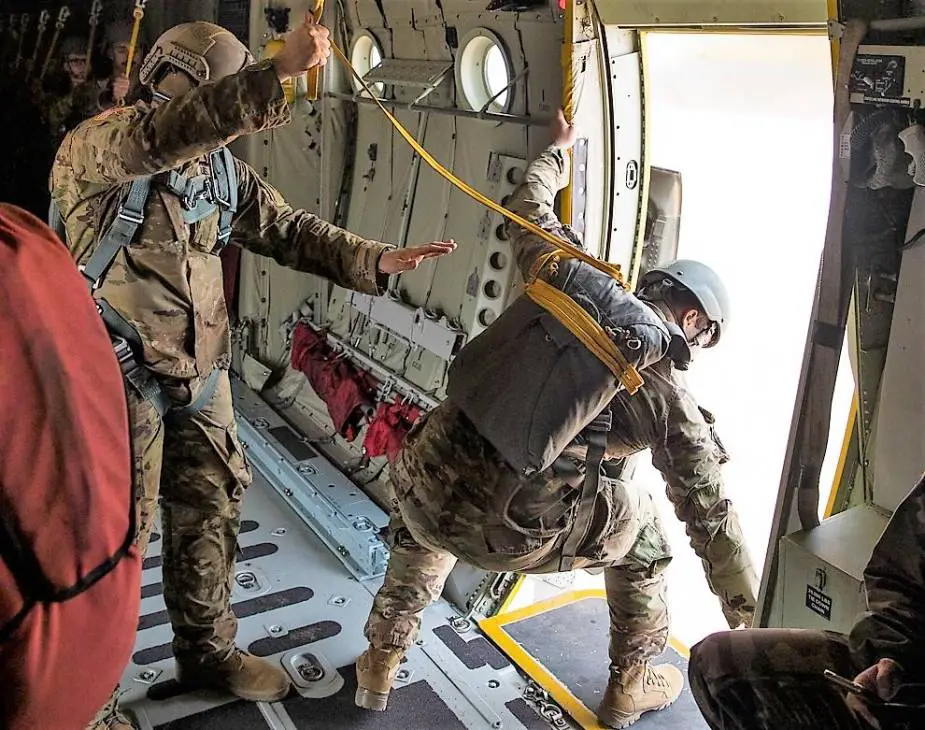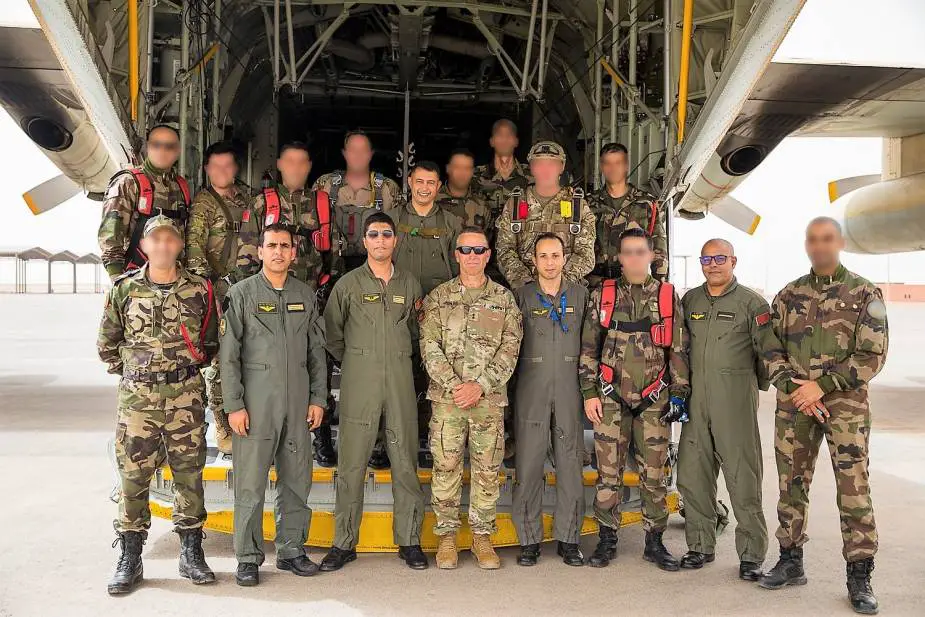Breaking news
US Moroccan and Tunisian paratroopers jump at African Lion 22.
Paratroopers from the 19th Special Forces Group (Airborne), Utah Army National Guard, Royal Moroccan Army and the Tunisian Land Army boarded a Moroccan C-130 in Grier Labouihi, Morocco, June 19, and conducted both military free-fall and static-line jumps. Maj. Brent Mangum reports on U.S. Army's website.
Follow Army Recognition on Google News at this link

U.S. Army Soldiers assigned to the 19th Special Forces Group (Airborne), Utah Army National Guard, perform the jumpmaster safety checks required before all the jumpers can exit the plane for a friendship airborne operation in Grier Labouihi, Morocco, during African Lion 22, on June 19, 2022. (Picture source: U.S. Army National Guard/Spc. Mackenzie Willden)
The jump — as an airborne operation is known — is part of African Lion 22, U.S. Africa Command's largest, premier, joint, annual exercise hosted by Morocco, Ghana, Senegal, and Tunisia, June 6-30. More than 7,500 participants from 28 nations and NATO are training together with a focus on enhancing readiness for U.S. and partner nation forces.
African Lion 22 is a joint, all-domain, multi-component and multinational exercise, employing a full array of mission capabilities with the goal of strengthening interoperability among participants and setting the theater for strategic access.
Soldiers traveled from Agadir to the Grier Labouihi training complex. Prior to the jump, U.S. Soldiers conducted Basic Airborne Refresher and Sustained Airborne Training courses. These courses are walk-through rehearsal exercises which help jumpers remember and visualize the most important elements of safely exiting an aircraft and landing without injuries.
“I was terrified because it has been over a year since I graduated jump school and I had a hard landing on rocks, but no serious injury,” said Sgt. Andrea Mendez, a Soldier with the 19th Special Forces Group. “I’d say I did a perfect [parachute landing fall] since I have bruises in all the right places. I was surprised at how well I handled the chute since it’s different from the ones we used at jump school.”
The traditional T-10 parachute used at jump school is un-steerable, while the MC-6 parachute — used by U.S. Special Operations Command — is considered maneuverable with toggles and air vents that allow for some limited steering.
Arriving at the airstrip, jumpers from each country donned their parachutes and then moved to a Jumpmaster Personnel Inspection, or JMPI, where they were inspected to ensure they were properly rigged and ready to safely jump.
“The whole thing was a huge challenge,” said Master Sgt. Dustin Boyack, a jumpmaster and the operation’s airborne commander. “When we went to the airborne coordination meeting, there was English, French and Arabic going back and forth, but in the end, it all worked out. The Group Support Battalion motto is ‘find a way, and we did."
And it was awesome to jump from a Moroccan aircraft and see their procedures, which we adapted to, and to see how they would adapt to our procedures,” Boyack continued. “For example, they jumped using their version of [Computer Automated Release Point] and we jumped using [Ground Marked Release System].”
In a Computer Automated Release Point jump the pilots give the green light to exit based on their navigation tools. While Ground Marked Release System, a jumpmaster in the aircraft will look for the release point by spotting panels on the drop zone before allowing paratroopers to exit the aircraft.
The participating countries’ paratroopers planned to hold a wing exchange ceremony June 28, a traditional event following a successful combined airborne operation.
Morocco was one of the first countries to recognize the newly independent U.S. when Sultan Mohammed III, in 1777, opened Morocco’s ports to American ships. Soon thereafter, Morocco formally recognized the U.S. by signing a treaty of peace and friendship in 1786, a document that remains the longest unbroken relationship in U.S. history.
In 2004, the U.S. designated Morocco a major non-NATO ally. Along with the thousands of active-duty U.S. troops that train in Morocco every year are hundreds of Utah’s service members. This year, Utah’s troops are training in and around the Moroccan cities of Agadir, Tifnit, Taliouine, Guelmim and Ben Guerir.
“Multinational exercises like African Lion allow the Utah National Guard’s State Partnership Program to continue to build and enhance professional relationships while supporting the interoperability of forces,” said Maj. Gen. Michael J. Turley, adjutant general, Utah National Guard. “They also allow both parties to further develop tactics, techniques, and procedures together, and advance the capabilities of all participants.”
The National Guard in each state in the U.S. has a partnership with one or more foreign partners. Utah’s partnership with Morocco was established in 2003 and has blossomed into a mature strategic partnership. The overarching goal is to support of U.S. government objectives in-country and within the region using a variety of military-to-military engagements.
The State Partnership Program has expanded to military-to-civilian and civilian-to-civilian interactions that support the whole-of-government and whole-of-society approach to U.S. security cooperation. Focus areas that support strategic lines of effort and the National Guard’s objectives are: Combined-arms capabilities, including Moroccan Special Operation Forces, Apache AH-64, artillery and F-16 refueling interoperability; humanitarian demining; emergency medicine; disaster response; noncommissioned officer development; and youth exchanges. These partnerships build strategic relationships in personal bonds and enduring trust.

U.S. Army Maj. Gen. Andrew M. Rohling, commander of Southern European Task Force, Africa, accompanied by Soldiers assigned to the 19th Special Forces Group (Airborne), Utah Army National Guard, and Royal Moroccan Army soldiers stand at the back of a Moroccan C-130 for a group photo during the friendship airborne operation in Grier Labouihi, Morocco, as part of African Lion 22, June 19, 2022 (Picture source: U.S. Army National Guard/Spc. Mackenzie Willden)

























